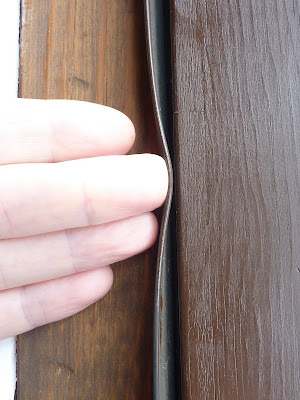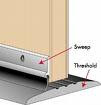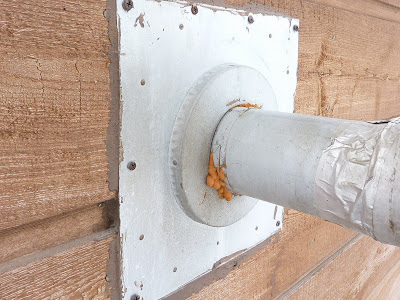
It's snowing at our house today. While most of the rest of the country has been having unusually cold weather, we've been having unusually warm. We live just 60 miles below the Canadian border in the Rockies and usually get a lot of snow in February, but the past week has been in the 40's and 50's instead! The forecast for today was high 40's and sunshine, so the snow this morning was a little unexpected.
Our 3-story home is entirely heated by one wood stove on the lowest level. It's radiant heat. There are no ducts, vents or blower to push the warm air through the house. Because we have two stairways, the main one and an additional spiral stair, there is a natural air circulation that happens as the heat rises and cold falls. The fire goes out, or is burned down to coals by morning, but the house was still warm and comfortable

this morning when we woke up, even with the snow falling outside. The home holds heat well in the winter, and stays cool in the summer. There are several simple things you can do to better maintain the temperature in your home, and save heating and cooling costs.
On a cold day, walk around the inside of your home and do a check around all the doors and windows. Hold your hand close to the edges of the door and move it all around the perimeter. You will feel cold air coming through the gaps if there is not a good seal. Do the same around the edges of the windows. Sometimes I can feel cold air pouring in through electrical outlets and plug-ins. Check around any other vents, flues or intakes.
If there is cold air coming in around a door, look at your weather stripping. It's either worn out, gone or doesn't fit well enough to do the job. First check to see what is already there. If it was well-fitting and efficient but just worn out, then buy the same kind to replace it with. There are many options for weather stripping.
The thin foam strip type is very

inexpensive to buy. It would be used to fill a small crack where the door comes against the lip of the door jam. But remember that you usually "get what you pay for". If it will be getting any amount of rubbing against it, it won't last long. It's a thin, flimsy type of weatherstripping, but does have it's value when used in the right circumstance.
The heavier foam tube or rubber types are more dense for better protection, and in most cases, will last much longer. Here are a few different types that are on the doors in our home:




Or you can attach a metal-backed weatherstrip to the outside door jam. When the door shuts, it seals against the tubular vinyl or rubber seal. In my opinion, these aren't as aesthetic as the hidden seals, but if it is what you need I'm sure the sacrifice will be well worth the savings. Even though the one in the picture is a silver metal, you can buy or paint it to match.
A door sweep, like the two shown below, will stop the draft from coming in under the door.


For your windows, there are various types of weatherstripping that are applied either inside or outside. Often, just a bead of caulk around the window frame will insulate against air coming through. Caulking and weatherstripping will also help keep the bugs out.



Electrical outlets are just a plastic box inserted between the outer wall and the Sheetrock on the inside, so there is no insulation between them.

For only a dollar or two, you can buy a foam insulating gasket. They go on the outside of the Sheetrock (inside wall), under the plate/cover. The picture shows gaskets that fit both outlets and switches. They are easy to install by just removing the cover, placing the

gasket around the switch or plugs, and then replacing the cover. Since cold air will still want to come through the holes in the plug outlet, insert some plastic child-protection covers into the outlet and no more cold air will be allowed through. So simple and inexpensive, and yet so effective!
Vents, pipes, gaps in siding, or other

areas that can let air through, can be insulated, caulked or filled in with foam spray insulation. This picture on the right is of foam spray insulation that was used to fill the gaps in our wood siding around doors and windows. The excess was removed so it would be less noticeable. The picture below is of a pellet stove vent pipe. It was sealed from the inside of the cover. You can see

some of the sealant that oozed out around the pipe. In spite of how it looks, it is well sealed and no cold air comes in around it. However, the pipe is a single-layer metal pipe that conducts cold to the inside through itself. We don't use the pellet stove and plan to remove it. When we do, we'll just remove the entire pipe and seal it over with an insulated cover.
Window blinds can make a very big difference in your heating and cooling. In the winter, I shut the blinds at night to add a little more protection from the cold

that comes through the glass. These insulated blinds do a great job of keeping heat in. When the sun shines during the day, I make sure the blinds are open on the sunny side of the house. We get a lot of solar heat through the windows. In the summer, we leave some windows open at night to cool the house back down after a hot day, and then make sure to close them in the morning before it starts getting hot outside. I also keep the blinds shut on the sunny side if it's too warm. Good quality windows make an enormous difference in heat loss/intake. If yours are really old and inefficient, you may want to consider saving up for some new ones.
While I was thinking about this today, I remembered an outlet in my kitchen that pours in the cold air. Looks like I still have plenty of projects to stay busy with! Although we're not paying for our heat, it is a lot of work to get 8 or 10 cord of firewood every year, so I'm highly motivated to do some more weatherizing!
Even if where you live normally has mild weather, we're all seeing that "normal" can't be counted on any more. Prepare now and be ready for crazy unexpected changes. Life gets very busy, but sometimes the smallest things can add up to the greatest benefit if we'll just take the time to give them a little attention. One report I read, said that improving the weatherizing around windows and doors, can save you better than 20% on heating bills! It's one more simple way to save some money and be better prepared for the storms ahead.
 Slippery Elm is one of my favorite herbs. It is a tree, native to North America, and the inner bark is the part used. It's an amazing, highly nutritious herb with a mild-flavor. To me it's a slightly nutty taste. In The How To Herb Book
Slippery Elm is one of my favorite herbs. It is a tree, native to North America, and the inner bark is the part used. It's an amazing, highly nutritious herb with a mild-flavor. To me it's a slightly nutty taste. In The How To Herb Book My How To Herb Book
My How To Herb Book









